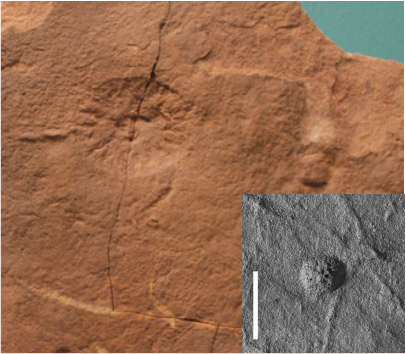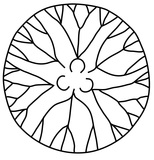RUGOCONITES enigmaticus
Glaessner and wade, 1966
|
Rugoconites enigmaticus is a dome-shaped fossil, with birfurcating ridges that radiate from its centre. Rugoconites was originally interpreted as an ancient medusoid (jellyfish). Subsequent descriptions have compared the tri-radial fossil with sponges (porifera) (Gehling & Rigby, 1996), however its classification is still uncertain.
Described from: Flinders Ranges, South Australia Key references: Glaessner & Wade, 1966 Gehling & Rigby, 1996 Jenkins, 1992 Hall et al. 2018 Jenkins, R.J.F., 1992. Functional and Ecological aspects of Ediacaran Assemblages. In Origin and Early evolution of the Metazoa. Lipps, J.H. & Signor, P.W., eds, New York, Plenum Press, 131-176. |
|
Taxonomic diagnosis (from Glaessner & Wade, 1966):
Periphery circular to oval. A few radial ridges diverge from a small central elevation or polygonal ridge, and branch dichotomously one to three times. The last dichotomy is, in each individual, a constant distance inside the periphery, and the resultant ridges curve slightly to meet the periphery at a right angle.
Periphery circular to oval. A few radial ridges diverge from a small central elevation or polygonal ridge, and branch dichotomously one to three times. The last dichotomy is, in each individual, a constant distance inside the periphery, and the resultant ridges curve slightly to meet the periphery at a right angle.
RUGOCONITES tenuirugosus
Glaessner and wade, 1966
The fossil Rugoconites tenuirugosus is similar to R. enigmaticus, although it appears to be much flatter, and its radial ridges are finer and more numerous.
Described from:
Flinders Ranges, South Australia
Key reference:
Wade, 1972
Described from:
Flinders Ranges, South Australia
Key reference:
Wade, 1972
Taxonomic diagnosis (Wade, 1972):
Rugoconites with very fine radial furrows which branch dichotomously about 3-5 times, diverging at a very low angle and tending to curve parallel; reticulations rare to common in different individuals; furrows reach smooth central area (?stomach).
Rugoconites with very fine radial furrows which branch dichotomously about 3-5 times, diverging at a very low angle and tending to curve parallel; reticulations rare to common in different individuals; furrows reach smooth central area (?stomach).


